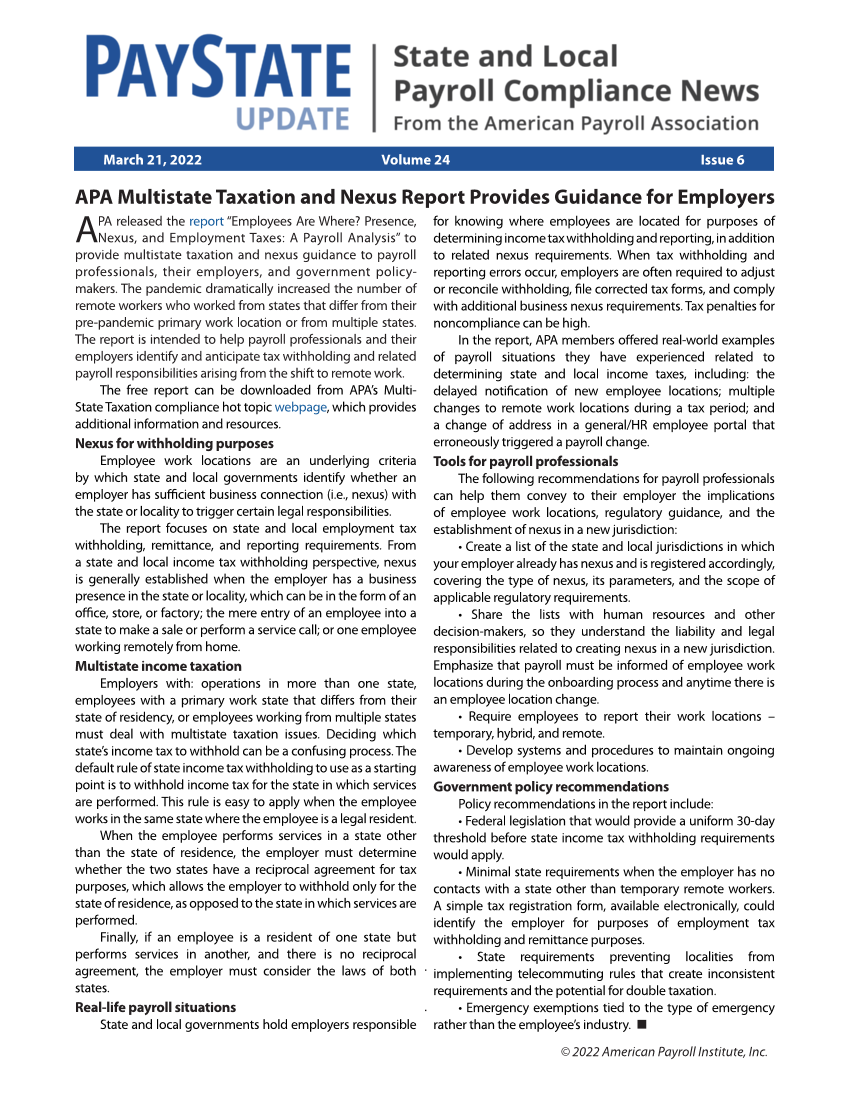© 2022 American Payroll Institute, Inc. APA Multistate Taxation and Nexus Report Provides Guidance for Employers APA released the report “Employees Are Where? Presence, Nexus, and Employment Taxes: A Payroll Analysis” to provide multistate taxation and nexus guidance to payroll professionals, their employers, and government policy- makers. The pandemic dramatically increased the number of remote workers who worked from states that differ from their pre-pandemic primary work location or from multiple states. The report is intended to help payroll professionals and their employers identify and anticipate tax withholding and related payroll responsibilities arising from the shift to remote work. The free report can be downloaded from APA’s Multi- State Taxation compliance hot topic webpage, which provides additional information and resources. Nexus for withholding purposes Employee work locations are an underlying criteria by which state and local governments identify whether an employer has sufficient business connection (i.e., nexus) with the state or locality to trigger certain legal responsibilities. The report focuses on state and local employment tax withholding, remittance, and reporting requirements. From a state and local income tax withholding perspective, nexus is generally established when the employer has a business presence in the state or locality, which can be in the form of an office, store, or factory the mere entry of an employee into a state to make a sale or perform a service call or one employee working remotely from home. Multistate income taxation Employers with: operations in more than one state, employees with a primary work state that differs from their state of residency, or employees working from multiple states must deal with multistate taxation issues. Deciding which state’s income tax to withhold can be a confusing process. The default rule of state income tax withholding to use as a starting point is to withhold income tax for the state in which services are performed. This rule is easy to apply when the employee works in the same state where the employee is a legal resident. When the employee performs services in a state other than the state of residence, the employer must determine whether the two states have a reciprocal agreement for tax purposes, which allows the employer to withhold only for the state of residence, as opposed to the state in which services are performed. Finally, if an employee is a resident of one state but performs services in another, and there is no reciprocal agreement, the employer must consider the laws of both states. Real-life payroll situations State and local governments hold employers responsible for knowing where employees are located for purposes of determining income tax withholding and reporting, in addition to related nexus requirements. When tax withholding and reporting errors occur, employers are often required to adjust or reconcile withholding, file corrected tax forms, and comply with additional business nexus requirements. Tax penalties for noncompliance can be high. In the report, APA members offered real-world examples of payroll situations they have experienced related to determining state and local income taxes, including: the delayed notification of new employee locations multiple changes to remote work locations during a tax period and a change of address in a general/HR employee portal that erroneously triggered a payroll change. Tools for payroll professionals The following recommendations for payroll professionals can help them convey to their employer the implications of employee work locations, regulatory guidance, and the establishment of nexus in a new jurisdiction: • Create a list of the state and local jurisdictions in which your employer already has nexus and is registered accordingly, covering the type of nexus, its parameters, and the scope of applicable regulatory requirements. • Share the lists with human resources and other decision-makers, so they understand the liability and legal responsibilities related to creating nexus in a new jurisdiction. Emphasize that payroll must be informed of employee work locations during the onboarding process and anytime there is an employee location change. • Require employees to report their work locations – temporary, hybrid, and remote. • Develop systems and procedures to maintain ongoing awareness of employee work locations. Government policy recommendations Policy recommendations in the report include: • Federal legislation that would provide a uniform 30-day threshold before state income tax withholding requirements would apply. • Minimal state requirements when the employer has no contacts with a state other than temporary remote workers. A simple tax registration form, available electronically, could identify the employer for purposes of employment tax withholding and remittance purposes. • State requirements preventing localities from implementing telecommuting rules that create inconsistent requirements and the potential for double taxation. • Emergency exemptions tied to the type of emergency rather than the employee’s industry. March 21, 2022 Volume 24 Issue 6
Printed for: PayrollOrg Bookshelf © 2024 American Payroll Institute, Inc. All Rights reserved. From: PayrollOrg Digital Publications (bookshelf.payroll.org)






